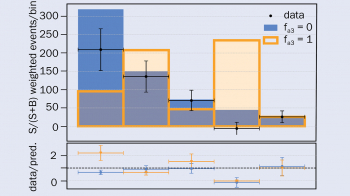By Jim Baggott
Oxford University Press
Hardback: £14.99 $24.95

Jim Baggott is the author of The Quantum Story, an exceptionally interesting and detailed “biography” of quantum physics, very nicely exposed over almost 500 pages. Having had the pleasure of reviewing this wonderful book for the CERN Courier, I was quite happy to learn, through a text by Steven Weinberg that appeared on 9 July this year on The New York Review of Books (NYRB) website, that Baggott had written a new book, succinctly titled Higgs. However, I was perplexed to realize that the new book had been finished just two days after the seminar at CERN on 4 July, when the ATLAS and CMS collaborations announced “the discovery of a new particle that seems to be the long-sought Higgs particle” (to quote Weinberg). Indeed, most of the book had been written well before, in anticipation of the day when the discovery would be announced.
Unfortunately, I became rather disappointed soon after getting my hands on the new book. Apart from Weinberg’s “foreword” (most of it available through the NYRB blog) and from the final chapters, most of the book left me with a feeling of “déjà vu“, constantly reminding me of pages from The Quantum Story. As the author writes in the preface, “the present book is based, in part, on that earlier work”. Some sentences were refurbished and some (not all) minor mistakes were corrected, but if you have read the original you will feel that much of the new book is a “remake”. At least Baggott has added a few Feynman diagrams, which were clearly lacking in The Quantum Story, such as the one relating the GIM mechanism to the dimuon decay of the neutral kaons, but a lot more illustrations (and a few equations) could have been included to facilitate the understanding of certain narratives.
The final three chapters of Higgs, written specifically for the new book, should have gone through an extra round of editing to eliminate several imperfections. For instance, the general reader will be puzzled when reading that the CMS collaboration is led by Guido Tonelli (page 188), that the CMS spokesperson is Tejinder Virdee (page 189) and that Joe Incandela is “acting as spokesperson for CMS” (page 215); the three sentences were no doubt correct when they were written but producing a good book implies more than copy/pasting sentences written over a period of several years. In general, the original chapters provide enjoyable reading but some details reveal that the author followed the action from far away and, in a few instances, became sidetracked by blog-driven animation. This constitutes an eye-opening experience for some readers (such as myself). Having followed the reality of the discovery as an insider and now seeing how things are written up in a popular-science book will allow me to assess the kind of “acceptance correction” that I should apply to analogous descriptions of the many things of which I have no direct knowledge. As an aside, I was amused to see that Baggott decided to illustrate the LHC’s achievements using a dimuon mass distribution that I helped to prepare but astonished to see that an error was introduced in the CMS Higgs plot when restyled for inclusion in the book. Things were really done too much in a hurry.
If you are looking for a good book to read over the end-of year break, I highly recommend The Quantum Story, a dense plot with heroic characters, covering the fantastic odyssey of quantum physics. But how many of us have crossed paths with Einstein, Bohr, Pauli or Dirac? It is refreshing to read books about present-day physics and physicists, where one can enjoy the plot and recognize the main characters. In that respect, Higgs is an interesting alternative and has the advantage of being much faster to read. Another option for people specifically interested in reading about the “hunt for the God particle”, is Massive, by Ian Sample, an easy-to-read, lively book that gives a fast-paced and well humoured overview of the history behind and surrounding the Higgs boson, until mid-2010, although the reader needs to be patient and ignore the annoying detail of seeing CERN written as Cern and RHIC as Rick … oh, well.
I am looking forward to reading more books about the LHC experiments and their discoveries, concerning Higgs physics and other topics, written by people who made those experiments and those discoveries. These are important issues and they deserve being treated by professionals with direct knowledge of the inside action, who can provide much more information – and much more accurately – than (award-winning) popular-science authors.








